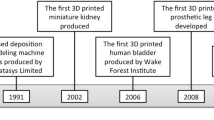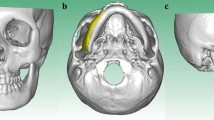Abstract
Background
Because of the limitation of specific preoperative design and surgical templates, orthognathic surgery and mandibular contour osteoplasty are generally performed in two stages. Three-dimensional printing technology has improved the accuracy of the surgery and results in good surgical predictability easily. This study aims to confirm the effectiveness, feasibility and precision of simultaneous mandibular contour osteoplasty and orthognathic surgery with the assistance of 3D printing technology.
Methods
Ten patients, who were diagnosed with mandibular hypertrophy and bimaxillary deformities, were included in the study. In addition to conventional orthognathic surgery, mandibular angle ostectomy, mandibular outer cortex grinding or mandibular border ostectomy was designed for mandibular hypertrophy. Optimal osteotomy lines and simulated surgeries were designed according the 3D printing model of the mandible. Then, surgical templates were made on the 3D printing model. No muscle excision was performed in any patient. Preoperative, predicted and postoperative measurements were taken, including the gonial angle (Ar–Go–Me) and the mandibular width (Go–Go).
Results
All the patients had a reposeful postoperative recovery, with no indication of obvious infection, facial paralysis, osteonecrosis or bone displacement. The gonial angle was improved from 110.3° ± 11.1 to 121.3° ± 2.9, and the mandibular width was improved from 117.5 mm ± 6.8 to 111.9 mm ± 4.2. The discrepancies between simulation and postoperation of the left gonial angle, the right gonial angle and the mandibular width were 0.56° ± 0.22, 0.65° ± 0.3 and 0.49 mm ± 0.43, respectively.
Conclusions
The results of our study illustrated the predictability, feasibility and reliability of simultaneous mandibular contour osteoplasty and orthognathic surgery with the assistance of 3D printing technology. Our technique could achieve functional improvement and an aesthetic profile at the same time.
Level of Evidence IV
This journal requires that authors assign a level of evidence to each article. For a full description of these Evidence-Based Medicine ratings, please refer to the Table of Contents or the online Instructions to Authors www.springer.com/00266.

















Similar content being viewed by others
References
Terajima M, Nakasima A, Aoki Y, Goto TK, Tokumori K, Mori N, Hoshino Y (2009) A 3-dimensional method for analyzing the morphology of patients with maxillofacial deformities. Am J Orthod Dentofacial Orthop 136(6):857–867
Lonic D, Lo LJ (2016) Three-dimensional simulation of orthognathic surgery-surgeon’s perspective. J Formos Med Assoc 115(6):387–388
Borzabadi-Farahani A, Eslamipour F, Shahmoradi M (2016) Functional needs of subjects with dentofacial deformities: a study using the index of orthognathic functional treatment need (IOFTN). J Plast Reconstr Aesthet Surg 69(6):796–801
Tian KY, Li QQ, Liu XJ, Wang XX, Li ZL, Wang X (2016) Evaluation of therapeutic effect of virtual design for correcting facial asymmetry of skeletal Class III deformity. Zhonghua Kou Qiang Yi Xue Za Zhi 51(10):594–599
Cousley RR, Turner MJ (2014) Digital model planning and computerized fabrication of orthognathic surgery wafers. J Orthod 41(1):38–45
Suojanen J, Leikola J, Stoor P (2017) The use of patient-specific implants in orthognathic surgery: a series of 30 mandible sagittal split osteotomy patients. J Craniomaxillofac Surg 44(12):1913–1916
Wang L, Tian D, Sun X, Xiao Y, Chen L, Wu G (2017) The precise repositioning instrument for genioplasty and a three-dimensional printing technique for treatment of complex facial asymmetry. Aesth Plast Surg. doi:10.1007/s00266-017-0875-2
Hernandez-Alfaro F, Guijarro-Martinez R (2013) New protocol for three-dimensional surgical planning and CAD/CAM splint generation in orthognathic surgery: an in vitro and in vivo study. J Oral Maxillofac Surg 42:1547–1556
Lee YC, Sohn HB, Kim SK, Bae OY, Lee JH (2015) A novel method for the management of proximal segment using computer assisted simulation surgery: correct condyle head positioning and better proximal segment placement. Maxillofac Plast Reconstr Surg 37(1):21
Gateno J, Xia JJ, Teichgraeber JF (2011) New 3-dimensional cephalometric analysis for orthognathic surgery. J Oral Maxillofac Surg 69(3):606–622
Popat H, Richmond S, Marshall D, Rosin P (2012) Three-dimensional assessment of functional change following class 3 orthognathic correction—a preliminary report. J Cranio maxillofac Surg 40:36–42
Ireland AJ, Cunningham SJ, Petrie A (2014) An index of orthognathic functional treatment need (IOFTN). J Orthod 41:77–83
Ye N, Long H, Zhu S (2015) The accuracy of computer image-guided template for mandibular angle ostectomy. Aesthet Plast Surg 39:117
Zhao M, ZWu G (2017) The appropriative retractors for genioplasty. J Craniofac Surg 28(1):252–253
Kim CH, Lee JH, Cho JY, Kim KW (2007) Skeletal stability after simultaneous mandibular angle resection and sagittal split ramus osteotomy for correction of mandible prognathism. J Oral Maxillofac Surg 65:192
Hsu SSP, Gateno J, Bell RB, Hirsch DL, Markiewicz MR, Teichgraeber JF, Zhou XB, Xia JJ (2013) Accuracy of a computer-aided surgical simulation protocol for orthognathic surgery: a prospective multicenter study. J Oral Maxillofac Surg 71(1):128–142
Tucker S, Cevidanes LHS, Styner M, Kim H, Reyes M, Proffit W, Turvey T (2010) Comparison of actual surgical outcomes and 3-dimensional surgical simulations. J Oral Maxillofac Surg 61(10):2412–2421
Marmulla R, Wo¨rtche R, Mu¨hling J, Hassfeld S (2005) Geometric accuracy of the NewTom 9000 cone beam CT. Dentomaxillofac Radiol 34:28–31
Maloney K, Bastidas J, Freeman K, Olson TR, Kraut RA (2011) Cone beam computed tomography and SimPlant materialize dental software versus direct measurement of the width and height of the posterior mandible: an anatomic study. J Oral Maxillofac Surg 69:1923–1929
Sun XM, Wu GM (2015) The precise repositioning instrument for genioplasty. J Craniofac Surg 26(8):2417
Mao XB, Wang T, Yang DK, Zang GM (2011) The dynamics of blood supply of animal experimental study for simultaneous mandibular sagittal split osteotomy and mandibular angle plasty. J Chongqing Med Univ 6(36):718–720
Anderson J Greg, Laney Thomas J (2002) Combined orthognathic and facial aesthetic surgery with case reports. J Tenn Dent Assoc 82(3):52
RaffainiM Pisani C (2015) Orthognathic surgery with or without autologous fat micrograft injection: preliminary report on aesthetic outcomes and patient satisfaction. Int J Oral Maxillofac Surg 44(3):362–370
Trawitzki LV, Dantas RO, Mello-Filho FV, Elias-Júnior J (2006) Effect of treatment of dentofacial deformity on masseter muscle thickness. Arch Oral Biol 51(12):1086–1092
Lee ST, Mori Y, Minami K, An CH, Park JW, Kwon TG (2013) Does skeletal surgery for asymmetric mandibular prognathism influence the soft tissue contour and thickness? J Oral Maxillofac Surg 71(9):1577–1587
Sarver DM, Rousso DR (2004) Plastic surgery combined with orthodontic and orthognathic procedures. Am J Orthod Dentofacial Orthop 126(3):305–307
Acknowledgements
This study was funded by grants from the Committee of National Nature Science Foundation (No. 81400532) in China, Norman Bethune Program of Jilin University (No. 2015301), Fund Project of Jilin Health and Family Planning Commission (No. 2015Q017), Jilin University’s Outstanding Young Teacher Training Program (No. 419080500367), the Program for Fundamental Research of Jilin University (No. 450060491134) and the 13th Five-Year science and technology project of the Education Department of Jilin Province (No. 2016486).
Author information
Authors and Affiliations
Corresponding author
Ethics declarations
Conflict of interest
The authors declare that they have no conflict of interest.
Ethical Approval
All procedures performed in studies involving human participants were in accordance with the ethical standards of the hospital research committee and with the 1964 Helsinki Declaration and its later amendments or comparable ethical standards.
Rights and permissions
About this article
Cite this article
Xiao, Y., Sun, X., Wang, L. et al. The Application of 3D Printing Technology for Simultaneous Orthognathic Surgery and Mandibular Contour Osteoplasty in the Treatment of Craniofacial Deformities. Aesth Plast Surg 41, 1413–1424 (2017). https://doi.org/10.1007/s00266-017-0914-z
Received:
Accepted:
Published:
Issue Date:
DOI: https://doi.org/10.1007/s00266-017-0914-z




